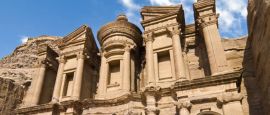Jordan Weather, climate and geography
Weather & climate
Jordan has a predominantly dry, desert climate, but temperatures vary considerably by season and region. Spring (March to May) is one of the most pleasant times to visit, with mild temperatures of around 15–25°C (59–77°F) and blooming wildflowers in the highlands. Summer (June to August) is hot and dry, especially in the Jordan Valley and Aqaba, where temperatures often reach 35–40°C (95–104°F), though the eastern desert can be even hotter. Amman, set at a higher elevation, remains noticeably cooler.
Autumn (September to November) brings comfortable temperatures of 20–30°C (68–86°F) and clear skies, making it another ideal season for travel. Winter (December to February) is cool to cold, particularly in Amman and the highlands, where temperatures can drop to 5–10°C (41–50°F) and occasional rain is expected. The desert can be surprisingly cold at night, and some areas even experience frost or light snowfall. The Dead Sea and Red Sea regions remain much warmer year-round.
Lightweight, breathable clothing is suitable for the hot summer months, particularly in the Jordan Valley, Aqaba and desert regions. In spring and autumn, light layers are recommended to accommodate warm days and cooler evenings. Winter visitors should bring warmer clothing, including a jacket or fleece, especially for Amman, Petra and the elevated highlands, where nights can be chilly.
Regardless of the season, modest clothing is advisable when visiting religious sites or rural areas. A hat, sunglasses and sun protection are useful in all warm-weather months. If visiting desert areas like Wadi Rum, a scarf or light covering can help with dust and sun exposure.
Geography
Jordan sits at the heart of the Middle East, bordered by Israel and the Palestinian Territories to the west, Syria to the north, Iraq to the east and Saudi Arabia to the south. Despite its compact size, the country's landscapes are strikingly varied. Much of northern and central Jordan consists of rolling highlands and fertile valleys, where cities like Amman, Salt and Irbid lie at cooler elevations. To the east stretches the vast Arabian Desert, a sparsely populated region of sand plains and basalt fields that gives way to the dramatic red landscapes of Wadi Rum — a favourite backdrop for film-makers.
To the west, the land drops steeply into the Jordan Rift Valley, where the River Jordan flows into the Dead Sea. This hypersaline lake, at about 430m (1,411ft) below sea level, marks the lowest point on Earth. Further south, Jordan's short coastline at Aqaba offers access to the Red Sea's warm waters and coral reefs. The country's geography has not only shaped its history and trade routes, but also makes it easy for travellers to experience desert sunsets, mountain views and underwater marine life all in a single trip.
Do you have any Feedback about this page?
© 2026 Columbus Travel Media Ltd. All rights reserved. No part of this site may be reproduced without our written permission, click here for information on Columbus Content Solutions.




 You know where
You know where